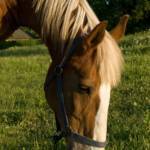Equine Laminitis: Update on Inflammation, Neutrophils

Those charged with caring for horses with laminitis know well the pain it causes. Despite far-reaching research efforts, neither a cure nor a one-size-fits-all treatment for laminitis has been identified. The complexity of both the hoof anatomy and the disease process slows the understanding of laminitis.
“Laminitis refers to inflammation of the microscopic finger-like projections of tissue called lamellae that connect the inner surface of the hoof wall to the outer surface of the coffin bone, which is the largest bone encased in the hoof. Once the lamellae become inflamed, they are weakened and no longer able to suspend the coffin bone inside the hoof,” said Laura Petroski, B.V.M.S., a veterinarian at Kentucky Equine Research. “If the horse tries to support its weight on the compromised limb, the hoof wall cannot hold the coffin bone in place, and devastating consequences ensue.”
Conditions capable of inducing laminitis include:
- Black walnut exposure;
- Supporting-limb loading;
- Systemic diseases such as diarrhea, colic, pneumonia, or metritis (uterine infection);
- Diet (grain overload, pasture-associated laminitis); and
- Hormonal abnormalities (Cushing’s disease or PPID, equine metabolic syndrome, insulin resistance).
Studies show that horses with laminitis generally have a guarded prognosis. Approximately 25% of horses remain lame and 50% of horses do not survive. To improve these odds, researchers continue to identify key factors in the disease process so targeted treatments can be developed. Because inflammation of the laminae is the defining hallmark of the disease, and neutrophils are integral to inflammation, researchers recently reviewed the role of neutrophils in laminitis.
After revisiting the function of neutrophils in various causes of laminitis, it seems neutrophils are main players only in the development of sepsis-related laminitis, such as cases precipitated by pneumonia, colic, or diarrhea. This study highlights that laminitis cannot be successfully managed with a single treatment strategy. “Good management, therefore, remains a mainstay in reducing the risk of horses developing laminitis,” Petroski emphasized.
Appropriate management strategies include, but are not limited to:
- Avoiding exposure to black walnut, excess grain, and lush pastures;
- Maintaining an appropriate body condition score;
- Effectively managing hormonal disorders; and
- Identifying systemic diseases and musculoskeletal injuries immediately in order to institute cryotherapy and other modalities as soon as possible to minimize the severity of disease.
“Offering a nutritional supplement containing biotin and other ingredients to support hoof growth and strength, such as Bio-Bloom PS (Bio-Bloom HF in Australia), is advisable after a bout of laminitis,” advised Petroski.
To help sidestep hindgut acidosis, which can be a precursor to laminitis, horses receiving large grain meals or grazing high-quality pasture can be supplemented with a hindgut buffer, like EquiShure, which helps maintain a healthy pH in the cecum and colon. By stabilizing the pH, the microbial population of the hindgut remains steady and functions optimally.
*Leise, B. The role of neutrophils in equine laminitis. Cell and Tissue Research. In press.








